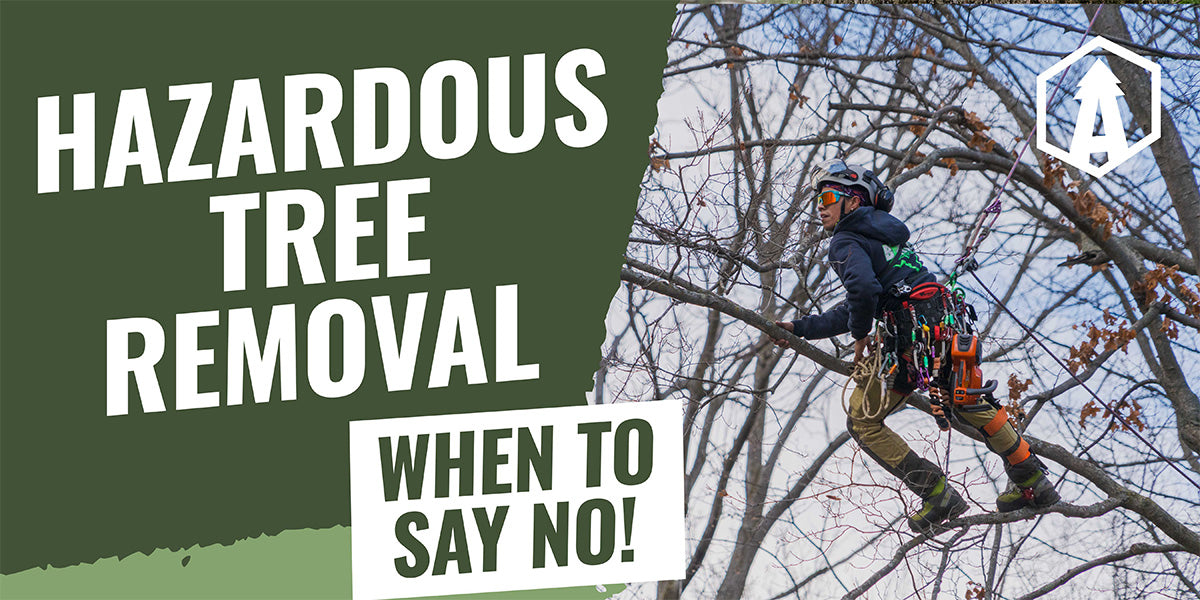
Hazardous Removal | When to say no!
Hazardous Removal: When to say no!
Prioritizing Safety
Safety is paramount when it comes to tree removal operations. As an arborist, my primary concern is not only preserving trees, but also ensuring the well-being of others, property and most importantly, myself. There will be situations that arise where saying no to a hazardous tree removal is the responsible and ethical choice. In this blog, we will outline some key factors to consider when deciding whether or not to proceed with a hazardous tree removal to keep safety in mind.
Hazard Assessment at the Point of Sale
Before undertaking any tree removal or any climbing job, it’s crucial to assess the severity of the hazard(s). Hazardous trees have the potential to pose various risks, such as falling limbs, uprooting, or structural instability. We, as arborists, use a systematic approach to evaluate these risks, considering factors like the tree’s condition, location, and potential targets. If the risk is deemed unmanageable, a risk to safety, it’s a clear indication to delay or reconsider the removal. That’s how it should go right? But as we all know too well, if we aren’t the salesperson or the owner of the company; we really don’t know what we’re about to get into, until we reach the job location.
We get our work orders electronically, or for some, on paper, but it will just read: “tree removal adjacent to yada-yada-yada”. However, it may fail to mention the condition of the tree and upon arrival, BOOM… Blindsided! But that’s just another day as a production crew because we weren’t the selling arborist. Now, it’s our job to determine if it is safe to climb, never take the word of a salesperson. Especially, if their job is only to sell and not climb! Upon inspection, you deem it unstable to climb, or stable to climb but unstable to handle the forces of rigging. What can be done in this instance? Say NO!
I have walked away from removals on separate occasions, there’s no shame in my game.
-
The first time I walked away from a removal was in the early years of my career and it was due to lack of skill. I hadn’t done a removal the size that was tasked and didn’t feel I could accomplish it without damaging the neighboring trees and the home that was adjacent to. The solution that day, the safety lead came to the jobsite and removed the tree. This was the first time I had seen anyone use pulleys and I walked away with valuable knowledge that I was able to apply to my next removal.
-
Another time I walked away was because the tree was WAY TOO crispy for any type of climbing! We were sent without a bucket truck because the salesman had indicated that a climber could perform the removal safely, not sadly; he was mistaken! A quick call to him informed him the removal was not going to happen without additional equipment, and busted a move elsewhere. The tree couldn’t be felled entirely but there was enough room to where I positively knew, a bucket truck could squeeze in AND still haul out debris. Solution, we came back with the bucket and removed it without issue! Sure, the call with the salesperson may have been tense, but he learned a lesson; if we can squeeze in the proper equipment, we will!
- Another memorable refusal was due to lack of skill, on the ground personnel’s behalf. This was an intricate removal; dare I say one of the hardest! Rigging everything down (nowhere to bomb any pieces out), close to two homes, and a garden underneath that the homeowners were adamant we protect! Both of my groundies were green and were put on my truck to train, this was not a good training job, so we refused it. Solution, we came back with my mentors’ crew and banged out the removal successfully with no damages!
We, the climbing arborists, are all under this notion that if we walk away, we aren’t shit! Pardon my French, but it’s the truth! Or it’s the “Hey, it's Mr. finish my tree” comments. Remember, the name of the game is to go home safely and do it all over again the next day. Do YOU want to risk it for the sake of being called a badass?! Now, I’m not saying refuse every tree that looks difficult because if you do, you’ll never progress and you’ll remain in limbo while your coworker’s advance. In order to get better, you have to push yourself past the limit but know when not to. Sounds funny but it’s the truth! If you have a crew member with years of experience, ask for their guidance. Afterall, they don’t want the big nasties all the time. There is a flipside; the more skill you acquire, the bigger and harder trees will be tossed your way. You could venture out and become a hired gun if that’s what you desire.
There are smart ways to approach the compromised removal.
-
Ask for assistance.
-
Request an aerial lift.
-
Tie-into an adjacent tree.
-
Rig into an adjacent tree.
-
Floating tie-in point.
-
CRANE.
-
Don’t do it!

Leave a comment